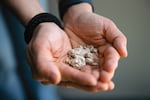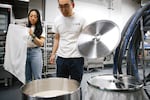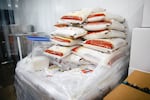
Siblings Sophia and Peter Jung, co-founders of Rainbrew, are portrayed in their tasting room on Thursday, May 22, 2025, in Woodinville, Wash.
Megan Farmer / KUOW
Many people enjoy sake, the Japanese rice wine. But now, a local brewing company is betting diners will soon make room for Korean rice wine.
Peter and Sophia Jung are the brother-sister team behind Rainbrew. At their Woodinville, Washington, brewery on a late day in May, they take the lid off a vat of rice porridge made with three basic ingredients: rice, water, and nuruk, a fermentation starter.
The mixture has the consistency of wet oatmeal.
“This is only three days old,” Peter said. “But you can smell the kind of fruitiness a little bit.”

Sophia Jung, co-founder of Rainbrew, holds a wild fermentation starter called nuruk, on Thursday, May 22, 2025, at the Rainbrew tasting room in Woodinville, Wash.
Megan Farmer / KUOW
After 10 days of fermenting, the batch will be filtered. The end product is rice wine called makgeolli, a traditional brew in Korea.
Of all the Korean alcoholic imports, this type of rice wine is the least known in the United States. But the Jung siblings hope to change that.
What makes makgeolli different from other rice wines is that it’s cloudy — almost milky — in color. It’s effervescent like kombucha.
“We also leave our stuff unpasteurized, which is really a big thing,” Sophia said. “That’s the traditional way of doing it … When you pasteurize it, it does change the flavor a little bit.”
“You get more complexity, I would also say funkiness, and also sourness because it’s a wild ferment,” Peter added. “So the sourness is similar to yogurts, or natural wine, or kombucha.”

Sophia and Peter Jung, co-founders of Rainbrew, check on the production of their Korean rice wine on Thursday, May 22, 2025, at the brewery in Woodinville, Wash.
Megan Farmer / KUOW
Peter Jung didn’t set out to become a brewer. It started as a pandemic project.
His mom spends half her time in Korea, where traditional makgeolli was making a comeback. But she couldn’t find that here in Seattle.
“The funny thing is we’re not really drinkers,” Peter said. “We’re kind of allergic. A lot of Asians have that genetic allergy to alcohol.”
In the process of researching and testing recipes, Peter found out makgeolli doesn’t cause the same adverse reaction, partly because of its lower alcohol content.
For the Jungs, the endeavor is more than just making rice wine — it’s about preserving a tradition that almost disappeared.
This humble brew, also known as farmers’ drink, was prohibited in Korea during Japanese occupation. Grain shortages also prolonged the ban.

Bags of rice for making Korean rice wine are stored in the walk-in cooler at Rainbrew, on Thursday, May 22, 2025, in Woodinville, Wash.
Megan Farmer / KUOW
These days, makgeolli is enjoying a revival. That’s thanks to the younger generation currently driving interest in making their own home brews — just like generations before them had done, before it became mass produced.
For Sophia Jung, working in the brewery connects her to her Korean roots.
“I kind of see it as a survival story, the fact that this is still around after all this time, after industrialization, after the war, and all that kind of stuff,” she said. ”Might as well see how much farther it can go and how much farther it can go outside of Korea.”
Related: Oregon’s sparkling wine scene is popping locally — and beyond
So, is America ready for makgeolli?
Lois Ko, owner of Sweet Alchemy Ice Creamery in Seattle, thinks so. Ko uses the lees, or the sediment left over from Rainbrew’s filtering process, to make ice cream. The flavor is winning fans, both her staff and customers.
“Some of my college student kids, they’re like, ‘it tastes like bread, like sweet white bread,’” Ko said.
People already drink sake and soju, Ko said. But compared to these alcoholic drinks, makgeolli is easier to drink.
The hard part, Ko said, might be the pronunciation — but she has a tip for those struggling with it.
“It’s pronounced like a ‘broccoli’ with an ‘m’ in the beginning,” she said. “Once you get it, then you get it.”
Woodinville’s Rainbrew is one of a handful of makgeolli brewers in the U.S.
The Jungs’ mother, whose search for locally-crafted makgeolli led to their venture, came up with the name. Sophia says the “Rainbrew” name reflects, in part, their home in the rainy city. But the name is also a reference to Korean tradition.
“In Korea, makgeolli was a rainy-day beverage,” she explained. “When it was raining outside people would say ‘let’s go drink makgeolli.’”
Ruby de Luna is a reporter with KUOW. This story comes to you from the Northwest News Network, a collaboration between public media organizations in Oregon and Washington.
It is part of OPB’s broader effort to ensure that everyone in our region has access to quality journalism that informs, entertains and enriches their lives. To learn more, visit our journalism partnerships page.